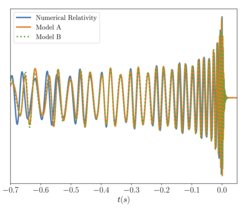Adding a bit of eccentricity
AEI researchers improve gravitational-wave form models for merging binary black holes by adding the effects of eccentric orbits
The analysis of gravitational-wave signals from merging binary black holes typically assumes that the two black holes spiral around each other on nearly circular orbits. For most binaries close to merger, this is expected to be a good assumption, but there may be some exceptions lurking among future observations of black-hole mergers. However, correctly interpreting the signal of eccentric binaries requires theoretical models that take the additional modulations induced by eccentricity into account. Using numerical-relativistic simulations, AEI researchers have now designed a method to add the signatures of eccentricity to already existing, highly accurate circular models.
Paper abstract
The detection of gravitational-wave signals from coalescing eccentric binary black holes would yield unprecedented information about the formation and evolution of compact binaries in specific scenarios, such as dynamical formation in dense stellar clusters and three-body interactions. The gravitational-wave searches by the ground-based interferometers, LIGO and Virgo, rely on analytical waveform models for binaries on quasi-circular orbits. Eccentric merger waveform models are less developed, and only a few numerical simulations of eccentric mergers are publicly available, but several eccentric inspiral models have been developed from the post-Newtonian expansion. Here we present a novel method to convert the dominant quadrupolar mode of any circular analytical binary-black-hole model into an eccentric model. First, using numerical simulations, we examine the additional amplitude and frequency modulations of eccentric signals that are not present in their circular counterparts. Subsequently, we identify suitable analytical descriptions of those modulations and inter-polate key parameters from twelve numerical simulations designated as our training dataset. This allows us to reconstruct the modulated amplitude and phase of any waveform up to mass ratio 3 and eccentricity 0.2. We find that the minimum overlap of the new model with numerical simulations is around 0.98 over all of our test dataset that are scaled to a 50 M⊙ black-hole binary starting at 35 Hz with aLIGO A+ design sensitivity. A PYTHON package Pyrex easily carries out the computation of this method.













